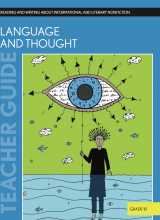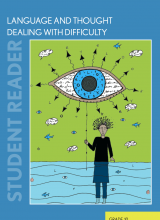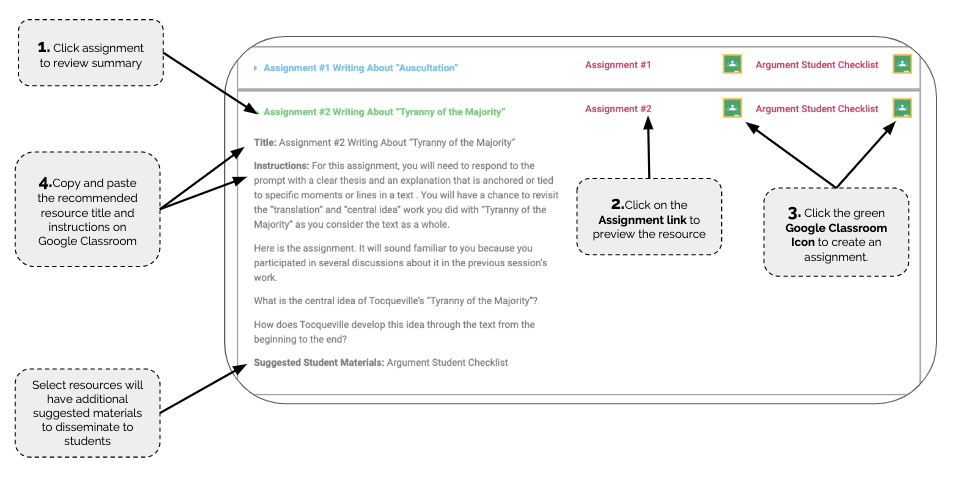Language and Thought - Grade 10
This unit consists of two cycles of work, each focused on a single text that explores the relationship between language and thought. While this relationship has been pondered by philosophers for centuries, recent research has made this topic especially relevant and compelling. Understanding this relationship sheds light on how something as commonplace as language can actually shape the way we think and perceive reality.


Table of Contents
Writing Tasks
Title: “The Power of Words in Wartime” Unfamiliar Terms and Confusing Moments
Teacher Manual Instructions:
Session 1
Give students a moment to individually skim back through the text, examine words and moments they marked during the first read, and mark any additional parts that stand out to them as being confusing or difficult.
Then, ask students to return to their small groups. As they work, students should share their initial markings with each other and review other portions of the text for additional ideas. Encourage students to use each other as a resource for simple questions and to build a list that contains the most significant or challenging difficulties they’ve identified. Give the groups 5-7 minutes to work on the first two columns of their chart.
Title: “Does Your Language Shape How You Think?” Unfamiliar Terms and Confusing Moments
Teacher Manual Instructions:
Session 4
Give students a moment to individually skim back through the text, examine words and moments they marked during the first read, and mark any additional parts that stand out to them as being confusing or difficult.
Then, ask students to return to their small groups. As they work, students should share their initial markings with each other and review other portions of the text for additional ideas. Encourage students to use each other as a resource for simple questions and to build a list that contains the most significant or challenging difficulties they’ve identified. Give the groups 7-8 minutes to work on the first two columns of their chart.
Title: Synthesizing the Two Texts
Teacher Manual Instructions:
Session 8
During the previous sessions, you worked hard to read, comprehend, and analyze two separate texts on the topic of language and thought. For this assignment, you will now have an opportunity to synthesize information from across these two texts.
Lera Boroditsky (2010), a professor and researcher at Stanford University who has devoted her career to studying the relationship between language and thought, wrote the following paragraphs in an article titled “Lost in Translation” in the Wall Street Journal:
“All this new research shows us that the languages we speak not only reflect or express our thoughts, but also shape the very thoughts we wish to express. The structures that exist in our languages profoundly shape how we construct reality, and help make us as smart and sophisticated as we are.
Language is a uniquely human gift. When we study language, we are uncovering in part what makes us human, getting a peek at the very nature of human nature. As we uncover how languages and their speakers differ from one another, we discover that human natures too can differ dramatically, depending on the languages we speak. The next steps are to understand the mechanisms through which languages help us construct the incredibly complex knowledge systems we have. Understanding how knowledge is built will allow us to create ideas that go beyond the currently thinkable. This research cuts right to the fundamental questions we all ask about ourselves. How do we come to be the way we are? Why do we think the way we do? An important part of the answer, it turns out, is in the languages we speak.”
Your task will be to respond to the question that Boroditsky poses at the end of this passage:
Considering the relationship between language and thought described by Lakoff and Deutscher, why do we think the way we do? |
Suggested Student Materials: Informational_Explanatory Checklist
Charts for Discussion
Title: What We Learned From Reading “The Power of Words in Wartime”
Teacher Manual Instructions:
Session 1
Facilitate a short whole-group share where the class collaborates to create a master list of this information. To create this master list, call on students to share what they learned from reading this text. Students should point to places in the text to support their responses. Capture student responses on a chart titled “What We Learned From Reading ‘The Power of Words in Wartime.’” Tell students since this is only their first read, and because they will be given multiple opportunities to reread this text, the intent is just to capture the gist of what they learned. It’s important to note that the pace of this “what we learned” activity is brisk and not at all comprehensive. This is a working chart that will be added to in the upcoming sessions.
Title: What We Learned From Reading “Does Your Language Shape How You Think?”
Teacher Manual Instructions:
Session 4
Facilitate a short whole-group share where the class collaborates to create a master list of this information. To create this master list, call on students to share what they learned from reading this text. Students should point to places in the text to support their responses. Capture student responses on a chart titled “What We Learned From Reading ‘Does Your Language Shape How You Think?.’” Tell students since this is only their first read, and because they will be given multiple opportunities to reread this text, the intent is just to capture the gist of what they learned. It’s important to note that the pace of this “what we learned” activity is brisk and not at all comprehensive. This is a working chart that will be added to in the upcoming sessions. Allow students a few extra minutes to record any additional insights from the master list into their own notebook.
Checks for Understanding
Title: “The Power of Words in Wartime”: Unfamiliar Terms and Confusing Moments
Teacher Manual Instructions:
Session 1
Reconvene the class and facilitate a whole-group share where the class collaborates to create the first two columns of the whole-class version of “‘The Power of Words in Wartime’: Unfamiliar Terms and Confusing Moments” chart.
To create this master chart, call on students to share the unfamiliar terms and confusing moments from their group list. Capture these in column one of the class chart. Be sure to include line numbers for each term or moment in the first column.
As students share their terms and moments, be sure to identify why the moment is difficult, especially if it is more than a simple question of vocabulary. Did the writer make a confusing comparison? Did he refer to an idea that you aren’t familiar with? Record these explanations in column two.
Tell students that the list of difficult moments they’ve created in their notebook might differ slightly from the master list they’ve created together as a class. Encourage students to record additional entries in their notebooks that they might have missed when they were working in their small groups. Let students know it is not necessary for them to record these additional entries in their notebook if they do not find the terms or moments offered by their peers to be difficult, confusing, or unclear.
Title: What We Learned About Identifying and Resolving Unfamiliar Terms or Difficult Moments
Teacher Manual Instructions:
Session 1
After the class has built a list of strategies for resolving difficulties, return to the list of moments from the text. Item by item, confirm that your list of strategies will provide a solution. If you come across a difficulty that does not yet have a possible solution, brainstorm ideas and add them to the list of strategies.
Finally, have students turn and talk to a partner about what they learned about the process of identifying unfamiliar terms or confusing moments. Ask a few students to share. Be sure to capture responses on a new chart titled “What We Learned About Identifying and Resolving Unfamiliar Terms or Difficult Moments.”
Title: “Does Your Language Shape How You Think?” Unfamiliar Terms and Confusing Moments
Teacher Manual Instructions:
Session 4
Reconvene the class and facilitate a whole-group share where the class collaborates to create the first two columns of the class chart titled “‘Does Your Language Shape How You Think?’ Unfamiliar Terms and Confusing Moments.”
To create this master chart, call on students to share the unfamiliar terms and confusing moments from their group list. Capture these in column one of the class chart. Be sure to include line numbers for each term or moment in the first column.
As students share their terms and moments, be sure to identify why the moment is difficult, especially if it is more than a simple question of vocabulary. Did the writer make a confusing comparison? Did he refer to an idea that you aren’t familiar with? Record these explanations in column two.
Tell students that the list of difficult moments they’ve created in their notebook might differ slightly from the master list they’ve created together as a class. Encourage students to record additional entries in their notebooks that they might have missed when they were working in their small groups. Let students know it is not necessary for them to record these additional entries in their notebook if they do not find the terms or moments offered by their peers to be difficult, confusing, or unclear.
Title: Findings and Evidence
Teacher Manual Instructions:
Session 6
Ask students to turn to a clean page in their notebook and write Deutscher’s claim at the top. Then ask them to create a two-column chart similar to the one nearby.
Work through completing this chart for the first major finding as a whole group. First, ask students to read the second section of this text (lines 132-219). When they’ve finished reading, give them about 3-4 minutes to work with a partner to (a) identify the major finding that supports the author’s overall claim in the essay; and (b) list the evidence that supports that major finding. Students should record their ideas on the chart in their notebook.
Check for understanding: Circulate around the room as pairs are working to provide support and guidance as needed.
When most pairs have finished, facilitate a whole-group discussion in which pairs share what they identified as the major finding in this section and the evidence that supports the finding. Record the information on a class version of the “Findings and Evidence” chart that all students can see.
Convene the whole group and facilitate a discussion in which pairs share what they identified as the major findings in the remaining sections and the evidence that supports those findings. Record the information on the class “Findings and Evidence” chart.
Independent Reading
Title: Book Interview
Instructions:
Display a copy of the “Book Interview” sheet for the class to see and distribute copies to students.
Using one of the books from the classroom library, model for students how to interview a book and how to fill out the sheet. Answer any questions students have about the form and its terminology.
Give students time to interview three books and to enter their findings on the “Book Interview” sheet.
Title: Book Pass
Instructions:
Organize students’ desks into a circle (or, if this is not possible, determine a very clear path for books to pass through the group).
Explain the purpose of a book pass:
A book pass is another way to expose students to the texts available in the classroom library. A book pass requires students to use their book interviewing skills. A book pass is a chance for students to find titles to add to their “Books I’d Like to Read” list.
Display a copy of the “Book Pass” for the class to see and pass out copies to students.
Demonstrate for the class how a person goes about making an entry on the form. Since students will need to write quickly, show how an author can be listed just by last name and first initial, and demonstrate how a student can abbreviate a long title if necessary. What matters is that they have enough information to track down the book again later if they need to.
Give each student one book (or magazine). Tell them it doesn’t matter which text they start with, because they will see all—or at least many of—the books. (Be sure you have one title for each student in the circle.)
Choose a direction for passing.
After students receive a book, they should immediately record the author’s name (if the text is a book) and title on the “Book Pass” form.
Give students one minute to interview each book following the procedure established in the previous session.
At the end of one minute, call “pass.” At this time, students should make an entry in the comments column and pass the book to the next student.
Continue the book pass until each student has interviewed all the books.
Title: Book Recommendation
Instructions:
Distribute copies of the “Book Recommendation” form to students and give them time to craft or begin crafting their first review. Students can choose to write about a book they’ve completed recently or one they remember well from past reading.
Title: Goals for My Reading Life
Instructions:
Display a copy of “Goals for My Reading Life” for the class to see and distribute copies to students.
Use this time to review how to fill out the goals sheet. Be sure to show students how they can use the charts to generate ideas for answers to the “Goals” questions.
Take a moment to stress the value and function of the “Books I’d Like to Read” list. Point out that this list is a tool that serves the same function as a bedside table for some readers: It is a place to store up titles or books that are “next in line.” Remind the class that readers constantly have their eyes open for “next” texts. A “Books I’d Like to Read List” is a way to prevent aimless and unproductive castings around for new reading materials. It’s a planning tool.
Explain that at the beginning of each marking period, each student will fill out a new goals sheet; at at the end of each marking period, students will take a few minutes to review their goals statements and reflect on their efforts to meet them.
Answer any questions students have about the “Goals for My Reading Life” forms.
Give students time to complete the form and set a deadline for submission. You may decide to photocopy these to keep a set for yourself. Return the forms to students during the next session and have them attach the form to a page in their notebook or save it for their student portfolio (see Creating a Student Portfolio).
Title: Reading Log
Teacher Manual Instructions:
Show students how to set up a “Reading Log” in their notebook. They should be sure to enter it in their table of contents. You may decide to distribute sticky notes so that students can flag this page. Use the model on the next page to guide your efforts.
Notice the column titled “Date Completed/# of Pages Read.” This column is a place for students to record, and receive credit for, the reading of texts that did not require a “cover-to-cover” experience. Be sure to point out that reading sections of several texts for specific purposes is not the same as skipping aimlessly from book to book to book. The former often indicates purposefulness and interest; the latter can indicate confusion or disengagement.
After students have set up the reading log—including proper headings, creating the grid, etc.—demonstrate how to make an entry.
Answer any questions students have about the log.
Remind students that the reading log is a tool to be used in conjunction with the “Goals” sheets. Students track their reading in the log and then use the log to evaluate their progress toward their goals.
If you plan to use student portfolios this year, consider introducing them at this time using some version of the information in the section that follows. Review Creating a Student Portfolio in advance to be sure you have thought through some of the important questions for portfolio work.
Unit Resources
Title: Grades 9 and 10 – Informational_Explanatory Rubric
Title: Scaffolds and Modifications: Descriptions and Use
